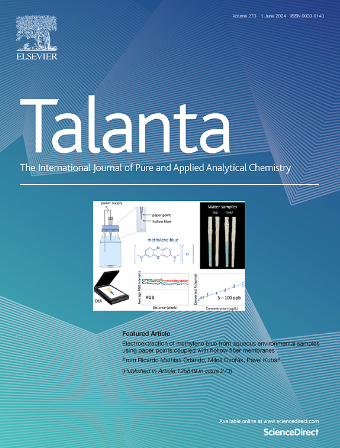开发用于痕量测定复杂离子源样品中溴化物的通用等位电泳-毛细管区带电泳方法
IF 6.1
1区 化学
Q1 CHEMISTRY, ANALYTICAL
引用次数: 0
摘要
采用毛细管区带电泳(CZE) -在线等速电泳(ITP) -样品前处理和200 nm光度检测技术,完成了水样和高纯度化学品中溴化物的痕量测定。溴对人类健康的不利影响使其有必要在饮用水中进行监测。溴也是溴酸盐的前体,溴酸盐是水消毒的致癌副产物,可在臭氧化(溴化物氧化为溴酸盐)过程中在饮用水中形成。在酸性pH(2.7)下进行ITP-CZE分离,这有利于分离系统的高选择性。在先导电解质中加入两性离子表面活性剂n -十二烷基- n, n -二甲基-3-氨-1-丙磺酸盐,促进了饮用水中溴化物与阴离子大组分的分离。第一个分离步骤ITP是一种非常有效的样品清理方法。在1 ~ 50 μg/L浓度范围内,基质存在和不存在均呈线性响应。ITP-CZE分离的特点是迁移时间重复性好(RSD达0.4%),溴的峰面积(RSD达3.7%)。在基质存在的情况下,溴化物的检出限为0.3 μg/L。为了评估所开发的测试程序的实际适用性,对矿泉水和饮用水以及高纯度氯化物盐的样品进行了分析。样品中溴化物的回收率在98 ~ 103%之间。所建立的ITP-CZE方法可用于高选择性测定离子源样品中痕量溴化物的浓度。本文章由计算机程序翻译,如有差异,请以英文原文为准。

Development of universal isotachophoresis – capillary zone electrophoresis method for trace determination of bromide in complex ionogenic samples
Trace determination of bromide in water samples and high-purity chemicals was accomplished by capillary zone electrophoresis (CZE) with online isotachophoresis (ITP) sample pretreatment and photometric detection at 200 nm. The adverse effect of bromide on human health necessitates its monitoring in drinking water. Bromide is also a precursor of bromate, a carcinogenic by-product of water disinfection that can be formed in drinking water during ozonation (oxidation of bromide to bromate). ITP-CZE separations were performed at acidic pH (2.7) as this facilitates high selectivity of the separation system. Addition of the zwitterionic surfactant N-dodecyl-N,N-dimethyl-3-ammonio-1-propanesulfonate to the leading electrolyte enhanced the separation of bromide from anionic macrocomponents in drinking water. The first separation step, ITP, served as a very efficient sample clean-up. Linear response was observed in the presence and absence of matrix in the concentration range 1–50 μg/L. ITP-CZE separations were characterized by very good repeatability of migration times (up to 0.4 % RSD) as well as peak areas (up to 3.7 % RSD) of bromide. The achieved limit of detection for bromide was 0.3 μg/L in the presence of matrix. To assess the practical applicability of the developed test procedure, samples of mineral and drinking water, as well as highly pure chloride salts, were analyzed. Recoveries of bromide in the analyzed samples were in the range of 98–103 %. The developed ITP-CZE method can be used for highly selective determination of trace concentrations of bromide present in ionogenic samples.
求助全文
通过发布文献求助,成功后即可免费获取论文全文。
去求助
来源期刊

Talanta
化学-分析化学
CiteScore
12.30
自引率
4.90%
发文量
861
审稿时长
29 days
期刊介绍:
Talanta provides a forum for the publication of original research papers, short communications, and critical reviews in all branches of pure and applied analytical chemistry. Papers are evaluated based on established guidelines, including the fundamental nature of the study, scientific novelty, substantial improvement or advantage over existing technology or methods, and demonstrated analytical applicability. Original research papers on fundamental studies, and on novel sensor and instrumentation developments, are encouraged. Novel or improved applications in areas such as clinical and biological chemistry, environmental analysis, geochemistry, materials science and engineering, and analytical platforms for omics development are welcome.
Analytical performance of methods should be determined, including interference and matrix effects, and methods should be validated by comparison with a standard method, or analysis of a certified reference material. Simple spiking recoveries may not be sufficient. The developed method should especially comprise information on selectivity, sensitivity, detection limits, accuracy, and reliability. However, applying official validation or robustness studies to a routine method or technique does not necessarily constitute novelty. Proper statistical treatment of the data should be provided. Relevant literature should be cited, including related publications by the authors, and authors should discuss how their proposed methodology compares with previously reported methods.
 求助内容:
求助内容: 应助结果提醒方式:
应助结果提醒方式:


